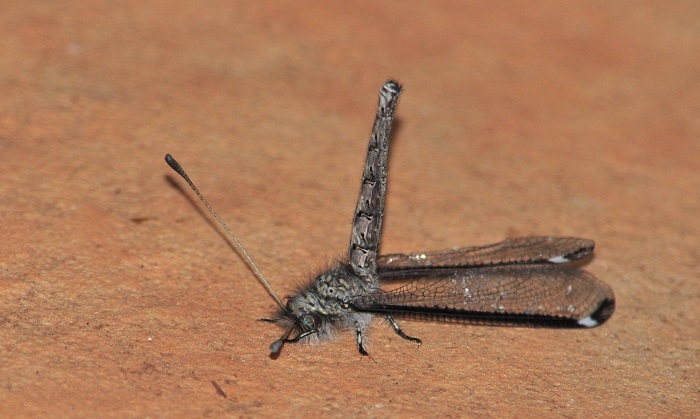This is the description of the Family Ascalaphidae in the online guide to the Neuroptera (lacewings and antlions) of southern Africa
Eight genera are known from South Africa: Tmesibasis; Proctarrelabis; Nephoneura; Eremoides; Allocormodes; Proctolyra; Neomelambrotus; Melambrotus
At least 50 species have been recorded in the region.
Identification
Medium sized (Wingspan 44-80 mm)
Adult Owlflies are unmistakable. Most have very long, clubbed antennae. Their bodies are generally quite hairy and they have two pairs of roughly equal sized wings. The eyes are well developed and larger than in other Neuropterans.
The resting posture, in the majority of species, is characteristic. The abdomen is held at an angle away from the thorax and wings.
The genus Tmesibasis is different in that they lack obvious clubs on the antennae. They also rest with their wings open and the abdomen is not held up at an angle. They have swollen, wasp-like abdomens and beautifully patterned, narrow-based wings.

Near Carnarvon, Northern Cape
Photo by Ryan Tippett

photo by Luke Verburgt
Behaviour
Most species are crepuscular (active at dawn and dusk).
The flight is swift, direct and powerful.
Adults are predatory and capture other insects on the wing. They hunt from a perch, detecting prey with their keen eyesight.
Food & Feeding
Adults are predators of smaller flying insects such as moths and flies. The larvae are voracious and feed on a range of walking or crawling insects.
Larvae
The larvae resemble those of antlions but are dorsoventrally flattened and have fringed projections on the sides of the body. They have huge jaws that can be opened up 180 degrees.
They are free-living and occur on tree bark or among leaf litter. They are very cryptic and have projections and bristles along their sides that collect debris to aid in camouflage.

Photo by Ryan Tippett
Distribution
Owlflies are widespread but seldom encountered in large numbers.

